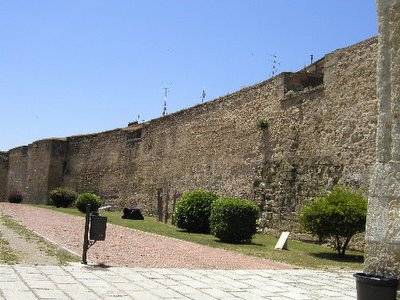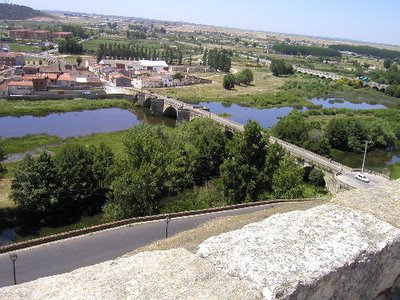If you’ve watched any of the Sharpe stories on TV (with the delicious Sean Bean as Sharpe) you’ll have some idea of what conditions were like for the soldiers who fought there. In the winter, it could be freezing cold, with the soldiers ploughing through deep snow, as was the case for their 250 mile retreat to Corunna in January 1809.
In the summer, the heat could be merciless. British soldiers, marching across the arid Spanish plain in searing heat, had no means of protecting their fair northern skins. The best they could do was to put an olive leaf on their lower lip, to stop it from bursting. That conjures up such a painful picture.
Last year, I visited some of the principal battle sites of the Peninsular War. Although it was only early June, the temperatures were incredible, up to 38 degrees C (= 100F). The Spanish central plain goes on for miles and miles, dotted with scrub and olive trees and with very little sign of water. Some of the rivers were dry, even so early in the year. I couldn’t help thinking about those marching soldiers, with aching bodies, blistered feet and parched throats, arriving at the river to drink and finding no water. Wellington may have called his men the “scum of the earth” but they certainly had staying power.
 At Ciudad Rodrigo, in 1812, Wellington lost nearly 600 men, with over 700 wounded. It’s not surprising the fortress was difficult to take. There are several sets of walls and they are still formidable, as you can see.
At Ciudad Rodrigo, in 1812, Wellington lost nearly 600 men, with over 700 wounded. It’s not surprising the fortress was difficult to take. There are several sets of walls and they are still formidable, as you can see.
The view from the ramparts by the square tower of the Alcazar shows the steep drop to the River Agueda. It would have been impossible to scale those walls without heavy loss of life.
 Ciudad Rodrigo itself is picturesque, exactly how one expects a Spanish town to be. Sadly, it did not look much like this after the battle, for the victorious troops indulged in a frenzy of drunken looting and violence. When order was eventually restored, they marched out “dressed in all varieties imaginable. Some with jack-boots on, others with white French trousers, others with frock-coats with epaulettes, some even with monkeys on their shoulders…” (according to Costello’s Adventures of a Soldier). But in spite of all that, the taking of Ciudad Rodrigo was a triumph for the Allies.
Ciudad Rodrigo itself is picturesque, exactly how one expects a Spanish town to be. Sadly, it did not look much like this after the battle, for the victorious troops indulged in a frenzy of drunken looting and violence. When order was eventually restored, they marched out “dressed in all varieties imaginable. Some with jack-boots on, others with white French trousers, others with frock-coats with epaulettes, some even with monkeys on their shoulders…” (according to Costello’s Adventures of a Soldier). But in spite of all that, the taking of Ciudad Rodrigo was a triumph for the Allies.Much food for thought for a Regency author. And for readers, too, perhaps.
Best wishes for 2006 to everyone
Joanna

4 comments:
What a great post. Those photos are fantastic.
I did do a bit of research into Corunna. Not the best of campaigns, but a test of endurance it's hard to imagine.
Lynne Connolly
Lovely pictures! I've written a scene set in Rodrigo but never had at the chance to visit it so I had to rely on maps, photos and some other experiences of visiting hill-top towns in the South of France and Spain.
Wonderful photos, Joanna, and a vivid description. I could see the soldiers myself as I was reading your post.
Writing Historical Fiction is such a nice excuse to travel places, isn't it? :-)
I wish I had more money. There's a lot more places I need/want to see.
Post a Comment